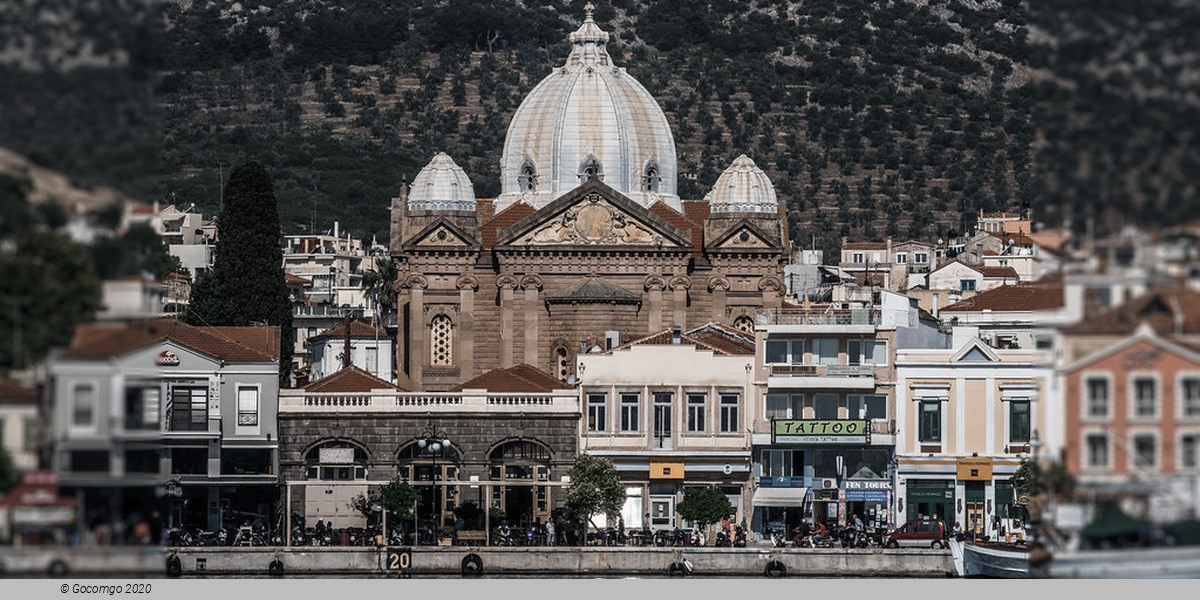Mytilene

Mytilene is the capital of the Greek island of Lesbos, and its port. It is also the capital and administrative centre of the North Aegean Region and hosts the headquarters of the University of the Aegean. It was founded in the 11th century BC. Mytilene is one of the 13 municipalities on the island of Lesbos. Mytilene is built on the southeast edge of the island. It is the seat of a metropolitan bishop of the Eastern Orthodox Church.
History
As an ancient city, lying off the east coast, Mytilene was initially confined to a small island just offshore that later was joined to Lesbos, creating a north and south harbour. The early harbours of Mytilene were linked during ancient times by a channel 700 meters long and 30 meters wide. The Roman writer Longus speaks of white stone bridges linking the two sides. The Greek word εὔριπος eúripos is a commonly-used term when referring to a strait. The strait allowed ancient warships called triremes, with three tiers of rowers or more. The boats that passed were ca. six meters wide plus oars and had a depth of two meters.
The areas of the city that were densely populated connected the two bodies of land with marble bridges. They usually followed a curved line. The strait begins at the old market called Apano Skala. It was also close to Metropolis Street and ended at the Southern Harbor. One could argue that the channel transversed what is now called Ermou Street. Over time the strait began to collect silt and earth. There was also human intervention for the protection of the Castle of Mytilene. The strait eventually filled with earth.
Mytilene contested successfully with Mithymna in the north of the island for the leadership of the island in the seventh century BC and became the centre of the island's prosperous eastern hinterland. Her most famous citizens were the poets Sappho and Alcaeus and the statesman Pittacus (one of the Seven Sages of Greece). The city was famed for its great output of electrum coins struck from the late sixth through mid-fourth centuries BC.
The Mytilenean revolt against Athens in 428 BC was overcome by an Athenian expeditionary force. The Athenian public assembly voted to massacre all the men of the city and to sell the women and children into slavery but the next day in the Mytilenian Debate changed its mind. A fast trireme sailed the 186 nautical miles (344 km) in less than a day and brought the decision to cancel the general massacre, but a thousand citizens were executed for taking part in the rebellion.
Aristotle lived on Mytilene for two years, 337–335 BC, with his friend and successor, Theophrastus (a native of the island), after being the tutor to Alexander, son of King Philip II of Macedon.
The Romans, among whom was a young Julius Caesar, successfully defeated Mytilene in 81 BC at the Siege of Mytilene. Although Mytilene supported the losing side in most of the great wars of the first century BC, her statesmen succeeded in convincing Rome of her support of the new ruler of the Mediterranean and the city flourished in Roman times.
In AD 56, Luke the Evangelist, Paul the Apostle and their companions stopped there briefly on the return trip of Paul's third missionary journey, having sailed from Assos (about 50 km away). From Mytilene, they continued towards Chios.
The novel Daphnis and Chloe by Longus is set in the country around it and opens with a description of the city.
Scholar and historian Zacharias Rhetor, also known as Zacharias of Mytilene was from Mytilene and lived from 465 to around 536. He was made Bishop of Mytilene and may have been a Chalcedonian Christian. He either died and or was deposed around 536 and 553.
The city of Mytilene was also home to ninth-century Byzantine saints who were brothers, Archbishop George, Symeon Stylites, and David the Monk. The Church of St. Symeon, Mytilene venerates one of the three brothers.
Catching the eye of the Empress Zoë Porphyrogenita, Constantine IX Monomachos was exiled to Mytilene on the island of Lesbos by her second husband, Michael IV the Paphlagonian. The death of Michael IV and the overthrow of Michael V in 1042 led to Constantine being recalled from his place of exile and appointed as a judge in Greece.
Lesbos and Mytilene had an established Jewish population since ancient times. In 1170, Benjamin of Tudela found ten small Jewish communities on the island.
In the Middle Ages, it was part of the Byzantine Empire and was occupied for some time by the Seljuqs under Tzachas in 1085. In 1198, the Republic of Venice obtained the right to commerce from the city's port.
In the 13th century, it was captured by the Emperor of Nicaea, Theodore I Laskaris. In 1335, the Byzantines, with the help of Ottoman forces, reconquered the island, then the property of the Genoese nobleman Domenico Cattaneo. In 1355, emperor John V Palaiologos gave it to the Genoese adventurer Francesco Gattilusio, who married the emperor's sister, Maria. They renovated the fortress in 1373, and it remained in Genoese hands until 1462 when it was besieged and captured by the Ottoman sultan Mehmed the Conqueror.
Mytilene along with the rest of Lesbos remained under Ottoman control until the First Balkan War in 1912 when in November it became part of the Kingdom of Greece.

